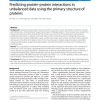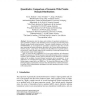BMCBI
2011
13 years 7 months ago
2011
Background: Since its inception, proteomics has essentially operated in a discovery mode with the goal of identifying and quantifying the maximal number of proteins in a sample. I...
BMCBI
2011
13 years 7 months ago
2011
Background: Accurate identification of protein domain boundaries is useful for protein structure determination and prediction. However, predicting protein domain boundaries from a...
BMCBI
2010
13 years 7 months ago
2010
Background: Ever since the ground-breaking work of Anfinsen et al. in which a denatured protein was found to refold to its native state, it has been frequently stated by the prote...
BMCBI
2010
13 years 7 months ago
2010
Background: Profile HMMs (hidden Markov models) provide effective methods for modeling the conserved regions of protein families. A limitation of the resulting domain models is th...
BMCBI
2010
13 years 7 months ago
2010
Background: The dynamic motions of many proteins are central to their function. It therefore follows that the dynamic requirements of a protein are evolutionary constrained. In or...
BMCBI
2010
13 years 7 months ago
2010
Background: Elucidating protein-protein interactions (PPIs) is essential to constructing protein interaction networks and facilitating our understanding of the general principles ...
CORR
2009
Springer
13 years 10 months ago
2009
Springer
dels at different abstraction levels; in particular, higher-level (e.g. membrane) activities can be given a formal biological justification in terms of low-level (i.e., protein) in...
PRIB
2010
Springer
13 years 10 months ago
2010
Springer
Abstract. An important unsolved problem in structural bioinformatics is that of protein structure prediction (PSP), the reconstruction of a biologically plausible three-dimensional...
ISBRA
2010
Springer
13 years 10 months ago
2010
Springer
The study of non-sequential alignments, with different connectivity of the aligned fragments in the proteins being compared can offer a more complete picture of the structural, evo...
GCB
2010
Springer
13 years 10 months ago
2010
Springer
Abstract: Investigations into the origins and evolution of regulatory mechanisms require quantitative estimates of the abundance and co-occurrence of functional protein domains amo...







